华为交换机配置调整端口命令
- 格式:doc
- 大小:30.00 KB
- 文档页数:2

目录第1章以太网端口配置命令....................................................................................................1-11.1 以太网端口配置命令..........................................................................................................1-11.1.1 broadcast-suppression............................................................................................1-11.1.2 copy configuration...................................................................................................1-11.1.3 description...............................................................................................................1-21.1.4 display counters......................................................................................................1-31.1.5 display interface......................................................................................................1-41.1.6 display port..............................................................................................................1-61.1.7 display port vlan-vpn...............................................................................................1-71.1.8 duplex......................................................................................................................1-81.1.9 flow-control..............................................................................................................1-81.1.10 link-status hold......................................................................................................1-91.1.11 interface...............................................................................................................1-101.1.12 jumboframe enable.............................................................................................1-101.1.13 loopback..............................................................................................................1-111.1.14 mdi.......................................................................................................................1-111.1.15 port access vlan..................................................................................................1-121.1.16 port hybrid pvid vlan............................................................................................1-131.1.17 port hybrid vlan....................................................................................................1-131.1.18 port link-type........................................................................................................1-141.1.19 port-mode............................................................................................................1-151.1.20 port trunk permit vlan..........................................................................................1-151.1.21 port trunk pvid vlan..............................................................................................1-161.1.22 reset counters interface.......................................................................................1-171.1.23 shutdown.............................................................................................................1-171.1.24 speed...................................................................................................................1-181.1.25 vlan-vpn enable...................................................................................................1-19第2章以太网端口汇聚配置命令............................................................................................2-12.1 以太网端口汇聚配置命令...................................................................................................2-12.1.1 debugging lacp packet............................................................................................2-12.1.2 debugging lacp state...............................................................................................2-12.1.3 debugging link-aggregation error............................................................................2-22.1.4 debugging link-aggregation event...........................................................................2-32.1.5 display lacp system-id.............................................................................................2-32.1.6 display link-aggregation summary...........................................................................2-42.1.7 display link-aggregation verbose.............................................................................2-52.1.8 display link-aggregation interface............................................................................2-72.1.9 lacp enable..............................................................................................................2-82.1.10 lacp port-priority.....................................................................................................2-82.1.11 lacp system-priority...............................................................................................2-92.1.12 link-aggregation.....................................................................................................2-92.1.13 link-aggregation group agg-id description...........................................................2-102.1.14 link-aggregation group agg-id mode...................................................................2-112.1.15 port link-aggregation group.................................................................................2-112.1.16 reset lacp statistics..............................................................................................2-12第3章 POS端口配置命令......................................................................................................3-13.1 POS端口配置命令.............................................................................................................3-13.1.1 clock........................................................................................................................3-13.1.2 crc............................................................................................................................3-13.1.3 description...............................................................................................................3-23.1.4 display interface pos...............................................................................................3-23.1.5 debugging ppp.........................................................................................................3-53.1.6 flag...........................................................................................................................3-63.1.7 frame-format............................................................................................................3-73.1.8 interface pos............................................................................................................3-73.1.9 loopback..................................................................................................................3-83.1.10 mtu........................................................................................................................3-93.1.11 pos access vlan.....................................................................................................3-93.1.12 ppp timer negotiate.............................................................................................3-103.1.13 reset counters interface pos................................................................................3-103.1.14 scramble..............................................................................................................3-113.1.15 shutdown.............................................................................................................3-123.1.16 threshold..............................................................................................................3-123.1.17 timer hold.............................................................................................................3-13第4章 RPR端口配置命令......................................................................................................4-14.1 RPR端口配置命令.............................................................................................................4-14.1.1 clock-source............................................................................................................4-14.1.2 debugging rpr..........................................................................................................4-14.1.3 display interface......................................................................................................4-24.1.4 display rpr defect.....................................................................................................4-64.1.5 display rpr fairness-para..........................................................................................4-74.1.6 display rpr protection...............................................................................................4-84.1.7 display rpr rs-table.................................................................................................4-104.1.8 display rpr statistics...............................................................................................4-114.1.9 display rpr timers...................................................................................................4-114.1.10 display rpr topology.............................................................................................4-124.1.11 flag.......................................................................................................................4-134.1.12 frame-format........................................................................................................4-144.1.13 port-type..............................................................................................................4-154.1.14 reset counters interface.......................................................................................4-154.1.15 rpr admin-request................................................................................................4-164.1.16 rpr echo...............................................................................................................4-174.1.17 rpr default-rs........................................................................................................4-174.1.18 rpr cos-precedence-map.....................................................................................4-184.1.19 rpr protect-mode..................................................................................................4-194.1.20 rpr reserve-band..................................................................................................4-194.1.21 rpr reversion-mode..............................................................................................4-204.1.22 rpr static-rs..........................................................................................................4-214.1.23 rpr station-name..................................................................................................4-214.1.24 rpr timer...............................................................................................................4-224.1.25 rpr weight.............................................................................................................4-234.1.26 sdh threshold.......................................................................................................4-234.1.27 shutdown.............................................................................................................4-24第5章 IDS联动配置命令........................................................................................................5-15.1 IDS联动配置命令...............................................................................................................5-15.1.1 acl-ids......................................................................................................................5-15.1.2 display acl ids..........................................................................................................5-1第1章以太网端口配置命令1.1 以太网端口配置命令1.1.1 broadcast-suppression【命令】broadcast-suppression pctundo broadcast-suppression【视图】以太网端口视图【参数】pct:指定以太网端口最大广播流量的线速度百分比,百分比越小,则允许通过的广播流量也越小。

华为路由器交换机配置命令大全华为路由器交换机配置大全本文提供XXX路由器交换机的配置命令,包括计算机命令和交换机命令。
一、计算机命令以下是一些常用的计算机命令:shutdown-hnow;关机init 0;关机logout;用户注销login;用户登录ifconfig;显示IP地址ifconfig eth0 netmask;设置IP地址ifconfig eht0 netmask down;禁用IP地址route add 0.0.0.0 gw;设置网关route del 0.0.0.0 gw;删除网关route add default gw;设置网关route del default gw;删除网关route;显示网关ping;发ECHO包;远程登录二、XXX路由器交换机配置命令以下是一些常用的XXX路由器交换机配置命令:Quidway]dis cur;显示当前配置Quidway]display n;显示当前配置Quidway]display interfaces;显示接口信息Quidway]display vlan;显示vlan信息Quidway]display n;显示版本信息Quidway]super password;修改特权用户密码Quidway]sysname;交换机命名Quidway]XXX;进入接口视图Quidway]interface vlan x;进入接口视图Quidway-Vlan-interface x]ip address 10.65.1.1 255.255.0.0;配置VLAN的IP地址Quidway]Ip route-static 0.0.0.0 0.0.0.0 10.65.1.2;静态路由=网关Quidway]rip;rip协议Quidway]local-user ftpQuidway]user-interface vty 0 4;进入虚拟终端S3026-ui-vty0-4]n-mode password;设置口令模式首先,这篇文章需要进行重新排版和编辑,以便更清晰地传达信息。

华为路由器交换机配置命令大全你还在为华为路由器交换机配置命令大全而烦恼么?不用担心,接下来是店铺为大家收集的华为路由器交换机配置命令大全,欢迎大家阅读:华为路由器交换机配置命令大全的方法一、计算机命令PCAlogin:root;使用root用户password:linux;口令是linux#shutdown-hnow;关机#init0;关机#logout;用户注销#login;用户登录#ifconfig;显示IP地址#ifconfigeth0netmask;设置IP地址#ifconfigeht0netmaskdown;禁用IP地址#routeadd0.0.0.0gw;设置网关#routedel0.0.0.0gw;删除网关#routeadddefaultgw;设置网关#routedeldefaultgw;删除网关#route;显示网关#ping;发ECHO包#telnet;远程登录二、华为路由器交换机配置命令:交换机命令[Quidway]discur;显示当前配置[Quidway]displaycurrent-configuration;显示当前配置[Quidway]displayinterfaces;显示接口信息[Quidway]displayvlanall;显示路由信息[Quidway]displayversion;显示版本信息[Quidway]superpassword;修改特权用户密码[Quidway]sysname;交换机命名[Quidway]interfaceethernet0/1;进入接口视图[Quidway]interfacevlanx;进入接口视图[Quidway-Vlan-interfacex]ipaddress10.65.1.1255.255.0.0;配置VLAN的IP地址[Quidway]iproute-static0.0.0.00.0.0.010.65.1.2;静态路由=网关[Quidway]rip;三层交换支持[Quidway]local-userftp[Quidway]user-interfacevty04;进入虚拟终端[S3026-ui-vty0-4]authentication-modepassword;设置口令模式[S3026-ui-vty0-4]setauthentication-modepasswordsimple222;设置口令[S3026-ui-vty0-4]userprivilegelevel3;用户级别[Quidway]interfaceethernet0/1;进入端口模式[Quidway]inte0/1;进入端口模式[Quidway-Ethernet0/1]duplex{half|full|auto};配置端口工作状态[Quidway-Ethernet0/1]speed{10|100|auto};配置端口工作速率[Quidway-Ethernet0/1]flow-control;配置端口流控[Quidway-Ethernet0/1]mdi{across|auto|normal};配置端口平接扭接[Quidway-Ethernet0/1]portlink-type{trunk|access|hybrid};设置端口工作模式[Quidway-Ethernet0/1]portaccessvlan3;当前端口加入到VLAN [Quidway-Ethernet0/2]porttrunkpermitvlan{ID|All};设trunk 允许的VLAN[Quidway-Ethernet0/3]porttrunkpvidvlan3;设置trunk端口的PVID[Quidway-Ethernet0/1]undoshutdown;激活端口[Quidway-Ethernet0/1]shutdown;关闭端口[Quidway-Ethernet0/1]quit;返回[Quidway]vlan3;创建VLAN[Quidway-vlan3]portethernet0/1;在VLAN中增加端口[Quidway-vlan3]porte0/1;简写方式[Quidway-vlan3]portethernet0/1toethernet0/4;在VLAN中增加端口[Quidway-vlan3]porte0/1toe0/4;简写方式[Quidway]monitor-port;指定镜像端口[Quidway]portmirror;指定被镜像端口[Quidway]portmirrorint_listobserving-portint_typeint_num;指定镜像和被镜像[Quidway]descriptionstring;指定VLAN描述字符[Quidway]description;删除VLAN描述字符[Quidway]displayvlan[vlan_id];查看VLAN设置[Quidway]stp{enable|disable};设置生成树,默认关闭[Quidway]stppriority4096;设置交换机的优先级[Quidway]stproot{primary|secondary};设置为根或根的备份[Quidway-Ethernet0/1]stpcost200;设置交换机端口的花费[Quidway]link-aggregatione0/1toe0/4ingress|both;端口的聚合[Quidway]undolink-aggregatione0/1|all;始端口为通道号[SwitchA-vlanx]isolate-user-vlanenable;设置主vlan[SwitchA]isolate-user-vlansecondary;设置主vlan包括的子vlan[Quidway-Ethernet0/2]porthybridpvidvlan;设置vlan的pvid [Quidway-Ethernet0/2]porthybridpvid;删除vlan的pvid[Quidway-Ethernet0/2]porthybridvlanvlan_id_listuntagged;设置无标识的vlan如果包的vlanid与PVId一致,则去掉vlan信息.默认PVID=1。
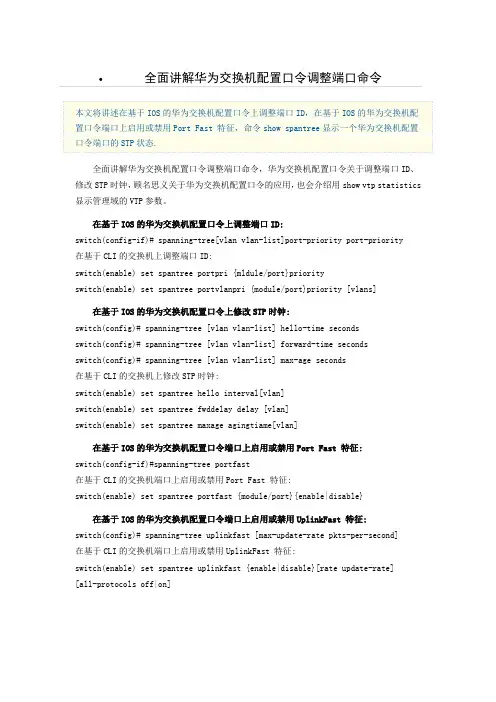
全面讲解华为交换机配置口令调整端口命令本文将讲述在基于IOS的华为交换机配置口令上调整端口ID,在基于IOS的华为交换机配置口令端口上启用或禁用Port Fast 特征,命令show spantree显示一个华为交换机配置口令端口的STP状态.全面讲解华为交换机配置口令调整端口命令,华为交换机配置口令关于调整端口ID、修改STP时钟,顾名思义关于华为交换机配置口令的应用,也会介绍用show vtp statistics 显示管理域的VTP参数。
在基于IOS的华为交换机配置口令上调整端口ID:switch(config-if)# spanning-tree[vlan vlan-list]port-priority port-priority 在基于CLI的交换机上调整端口ID:switch(enable) set spantree portpri {mldule/port}priorityswitch(enable) set spantree portvlanpri {module/port}priority [vlans] 在基于IOS的华为交换机配置口令上修改STP时钟:switch(config)# spanning-tree [vlan vlan-list] hello-time secondsswitch(config)# spanning-tree [vlan vlan-list] forward-time secondsswitch(config)# spanning-tree [vlan vlan-list] max-age seconds在基于CLI的交换机上修改STP时钟:switch(enable) set spantree hello interval[vlan]switch(enable) set spantree fwddelay delay [vlan]switch(enable) set spantree maxage agingtiame[vlan]在基于IOS的华为交换机配置口令端口上启用或禁用Port Fast 特征:switch(config-if)#spanning-tree portfast在基于CLI的交换机端口上启用或禁用Port Fast 特征:switch(enable) set spantree portfast {module/port}{enable|disable} 在基于IOS的华为交换机配置口令端口上启用或禁用UplinkFast 特征:switch(config)# spanning-tree uplinkfast [max-update-rate pkts-per-second]在基于CLI的交换机端口上启用或禁用UplinkFast 特征:switch(enable) set spantree uplinkfast {enable|disable}[rate update-rate][all-protocols off|on]为了将交换机配置成一个集群的命令交换机,首先要给管理接口分配一个IP地址,然后使用下列命令:switch(config)# cluster enable cluster-name为了从一条中继链路上删除VLAN,可使用下列华为交换机配置口令命令:switch(enable) clear trunk module/port vlan-range用show vtp domain 显示管理域的VTP参数.用show vtp statistics显示管理域的VTP参数.在Catalyst华为交换机配置口令上定义TrBRF的命令如下:switch(enable) set vlan vlan-name [name name] type trbrf bridge bridge-num[stp {ieee|ibm}]在Catalyst华为交换机配置口令上定义TrCRF的命令如下:switch (enable) set vlan vlan-num [name name] type trcrf{ring hex-ring-num|decring decimal-ring-num} parent vlan-num在创建好TrBRF VLAN之后,就可以给它分配交换机端口.对于以太网交换,可以采用如下命令给VLAN分配端口:switch(enable) set vlan vlan-num mod-num/port-num命令show spantree显示一个华为交换机配置口令端口的STP状态.配置一个ELAN的LES和BUS,可以使用下列命令:ATM (config)# interface atm number.subint multiointATM(config-subif)# lane serber-bus ethernet elan-name。
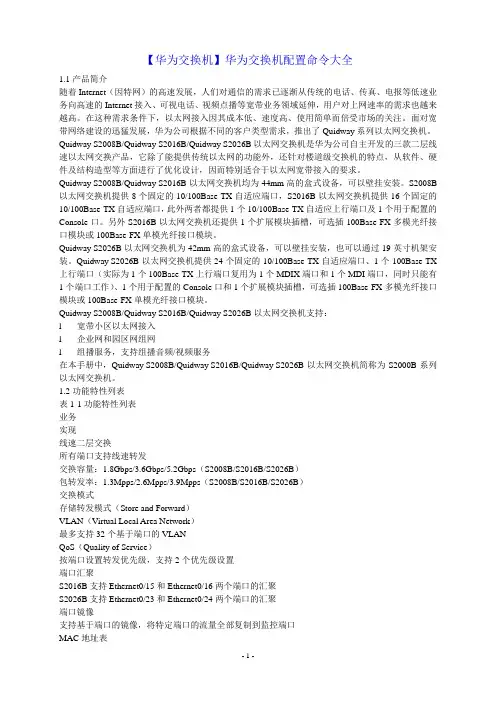
【华为交换机】华为交换机配置命令大全1.1 产品简介随着Internet(因特网)的高速发展,人们对通信的需求已逐渐从传统的电话、传真、电报等低速业务向高速的Internet接入、可视电话、视频点播等宽带业务领域延伸,用户对上网速率的需求也越来越高。
在这种需求条件下,以太网接入因其成本低、速度高、使用简单而倍受市场的关注。
面对宽带网络建设的迅猛发展,华为公司根据不同的客户类型需求,推出了Quidway系列以太网交换机。
Quidway S2008B/Quidway S2016B/Quidway S2026B以太网交换机是华为公司自主开发的三款二层线速以太网交换产品,它除了能提供传统以太网的功能外,还针对楼道级交换机的特点,从软件、硬件及结构造型等方面进行了优化设计,因而特别适合于以太网宽带接入的要求。
Quidway S2008B/Quidway S2016B以太网交换机均为44mm高的盒式设备,可以壁挂安装。
S2008B 以太网交换机提供8个固定的10/100Base-TX自适应端口,S2016B以太网交换机提供16个固定的10/100Base-TX自适应端口,此外两者都提供1个10/100Base-TX自适应上行端口及1个用于配置的Console口。
另外S2016B以太网交换机还提供1个扩展模块插槽,可选插100Base-FX多模光纤接口模块或100Base-FX单模光纤接口模块。
Quidway S2026B以太网交换机为42mm高的盒式设备,可以壁挂安装,也可以通过19英寸机架安装。
Quidway S2026B以太网交换机提供24个固定的10/100Base-TX自适应端口、1个100Base-TX 上行端口(实际为1个100Base-TX上行端口复用为1个MDIX端口和1个MDI端口,同时只能有1个端口工作)、1个用于配置的Console口和1个扩展模块插槽,可选插100Base-FX多模光纤接口模块或100Base-FX单模光纤接口模块。

H C华为交换机配置命令大全Revised final draft November 26, 2020H3C交换机配置命令大全1、system-view进入系统视图模式2、sysname为设备命名3、displaycurrent-configuration当前配置情况4、language-modeChinese|English中英文切换5、interfaceEthernet1/0/1进入以太网端口视图6、portlink-typeAccess|Trunk|Hybrid设置端口访问模式7、undoshutdown打开以太网端口8、shutdown关闭以太网端口9、quit退出当前视图模式10、vlan10创建VLAN10并进入VLAN10的视图模式11、portaccessvlan10在端口模式下将当前端口加入到vlan10中12、portE1/0/2toE1/0/5在VLAN模式下将指定端口加入到当前vlan中13、porttrunkpermitvlanall允许所有的vlan通过H3C路由器1、system-view进入系统视图模式2、sysnameR1为设备命名为R13、displayiprouting-table显示当前路由表4、language-modeChinese|English中英文切换5、interfaceEthernet0/0进入以太网端口视图6、ipaddress配置IP地址和子网掩码7、undoshutdown打开以太网端口8、shutdown关闭以太网端口9、quit退出当前视图模式10、iproute-staticdescriptionTo.R2配置静态路由11、iproute-static0.0.0.0descriptionTo.R2配置默认的路由H3CS3100SwitchH3CS3600SwitchH3CMSR20-20Router1、调整超级终端的显示字号;2、捕获超级终端操作命令行,以备日后查对;3、language-modeChinese|English中英文切换;4、复制命令到超级终端命令行,粘贴到主机;5、交换机清除配置:<H3C>resetsave;<H3C>reboot;6、路由器、交换机配置时不能掉电,连通测试前一定要检查网络的连通性,不要犯最低级的错误。

华为交换机基本配置命令一、单交换机VLAN划分命令命令解释system 进入系统视图system-view 进入系统视图quit 退到系统视图undo vlan 20 删除vlan 20sysname 交换机命名disp vlan 显示vlanvlan 20 创建vlan(也可进入vlan 20)port e1/0/1 to e1/0/5 把端口1-5放入VLAN 20 中disp vlan 20 显示vlan里的端口20int e1/0/24 进入端口24port access vlan 20 把当前端口放入vlan 20undo port e1/0/10 表示删除当前VLAN端口10disp curr 显示当前配置二、配置交换机支持TELNETsystem 进入系统视图sysname 交换机命名int vlan 1 进入VLAN 1ip address 192.168.3.100 255.255.255.0 配置IP地址user-int vty 0 4 进入虚拟终端authentication-mode password (aut password) 设置口令模式set authentication password simple 222 (set aut pass sim 222) 设置口令user privilege level 3(use priv lev 3) 配置用户级别disp current-configuration (disp cur) 查看当前配置disp ip int 查看交换机VLAN IP配置删除配置必须退到用户模式reset saved-configuration(reset saved) 删除配置reboot 重启交换机三、跨交换机VLAN的通讯在sw1上:vlan 10 建立VLAN 10int e1/0/5 进入端口5port access vlan 10 把端口5加入vlan 10vlan 20 建立VLAN 20int e1/0/15 进入端口15port access vlan 20 把端口15加入VLAN 20int e1/0/24 进入端口24port link-type trunk 把24端口设为TRUNK端口port trunk permit vlan all 同上在SW2上:vlan 10 建立VLAN 10int e1/0/20 进入端口20port access vlan 10 把端口20放入VLAN 10int e1/0/24 进入端口24port link-type trunk 把24端口设为TRUNK端口port trunk permit vlan all (port trunk permit vlan 10 只能为vlan 10使用)24端口为所有VLAN使用disp int e1/0/24 查看端口24是否为TRUNKundo port trunk permit vlan all 删除该句四、路由的配置命令system 进入系统模式sysname 命名int e1/0 进入端口ip address 192.168.3.100 255.255.255.0 设置IPundo shutdown 打开端口disp ip int e1/0 查看IP接口情况disp ip int brief 查看IP接口情况user-int vty 0 4 进入口令模式authentication-mode password(auth pass) 进入口令模式set authentication password simple 222 37 设置口令user privilege level 3 进入3级特权save 保存配置reset saved-configuration 删除配置(用户模式下运行)undo shutdown 配置远程登陆密码int e1/4ip route 192.168.3.0(目标网段) 255.255.255.0 192.168.12.1(下一跳:下一路由器的接口)静态路由ip route 0.0.0.0 0.0.0.0 192.168.12.1 默认路由disp ip rout 显示路由列表sw1(三层交换机):int vlan 10 创建虚拟接口VLAN 10ip address 192.168.10.254 255.255.255.0 设置虚拟接口VLAN 10的地址int vlan 20 创建虚拟接口VLAN 20ip address 192.168.20.254 255.255.255.0 设置虚拟接口IP VLAN 20的地址注意:vlan 10里的计算机的网关设为 192.168.10.254vlan 20里的计算机的网关设为 192.168.20.254[S9306-GigabitEthernet2/0/42]dis this#interface GigabitEthernet2/0/42 原先的为trunk,port link-type trunkport trunk allow-pass vlan 2 to 4094Duplex {auto/half/full}Speed {auto/10/100/1000}#interface GigabitEthernet2/0/42 现在改为accessundo port trunk allow-pass vlan allport trunk allow-pass vlan 1port link-type accessport default vlan 10Stp enableStp priority 4096Stp root {primary/secondary}华为路由器交换机配置命令:路由器命令[Quidway]displayversion;显示版本信息[Quidway]displaycurrent-configuration;显示当前配置[Quidway]displayinterfaces;显示接口信息[Quidway]displayiproute;显示路由信息[Quidway]sysnameaabbcc;更改主机名[Quidway]superpasswrod123456;设置口令[Quidway]interfaceserial0;进入接口[Quidway-serial0]ipaddress;配置端口IP地址[Quidway-serial0]undoshutdown;激活端口配置ospf[S9300-A] router id 1.1.1.1[S9300-A] ospf 100[S9300-A-ospf-100] area 0[S9300-A-ospf-100-area-0.0.0.0] network 192.168.0.0 0.0.0.255 [S9300-A-ospf-100-area-0.0.0.0] quit[S9300-A-ospf-1] area 1[S9300-A-ospf-100-area-0.0.0.1] network 192.168.1.0 0.0.0.255 [S9300-A-ospf-100-area-0.0.0.1] quit[S9300-A-ospf-1] quit。
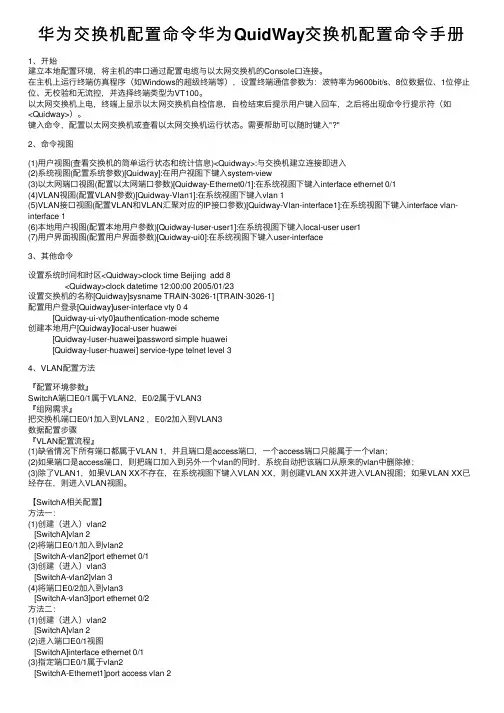
华为交换机配置命令华为QuidWay交换机配置命令⼿册1、开始建⽴本地配置环境,将主机的串⼝通过配置电缆与以太⽹交换机的Console⼝连接。
在主机上运⾏终端仿真程序(如Windows的超级终端等),设置终端通信参数为:波特率为9600bit/s、8位数据位、1位停⽌位、⽆校验和⽆流控,并选择终端类型为VT100。
以太⽹交换机上电,终端上显⽰以太⽹交换机⾃检信息,⾃检结束后提⽰⽤户键⼊回车,之后将出现命令⾏提⽰符(如<Quidway>)。
键⼊命令,配置以太⽹交换机或查看以太⽹交换机运⾏状态。
需要帮助可以随时键⼊"?"2、命令视图(1)⽤户视图(查看交换机的简单运⾏状态和统计信息)<Quidway>:与交换机建⽴连接即进⼊(2)系统视图(配置系统参数)[Quidway]:在⽤户视图下键⼊system-view(3)以太⽹端⼝视图(配置以太⽹端⼝参数)[Quidway-Ethernet0/1]:在系统视图下键⼊interface ethernet 0/1(4)VLAN视图(配置VLAN参数)[Quidway-Vlan1]:在系统视图下键⼊vlan 1(5)VLAN接⼝视图(配置VLAN和VLAN汇聚对应的IP接⼝参数)[Quidway-Vlan-interface1]:在系统视图下键⼊interface vlan-interface 1(6)本地⽤户视图(配置本地⽤户参数)[Quidway-luser-user1]:在系统视图下键⼊local-user user1(7)⽤户界⾯视图(配置⽤户界⾯参数)[Quidway-ui0]:在系统视图下键⼊user-interface3、其他命令设置系统时间和时区<Quidway>clock time Beijing add 8<Quidway>clock datetime 12:00:00 2005/01/23设置交换机的名称[Quidway]sysname TRAIN-3026-1[TRAIN-3026-1]配置⽤户登录[Quidway]user-interface vty 0 4[Quidway-ui-vty0]authentication-mode scheme创建本地⽤户[Quidway]local-user huawei[Quidway-luser-huawei]password simple huawei[Quidway-luser-huawei] service-type telnet level 34、VLAN配置⽅法『配置环境参数』SwitchA端⼝E0/1属于VLAN2,E0/2属于VLAN3『组⽹需求』把交换机端⼝E0/1加⼊到VLAN2 ,E0/2加⼊到VLAN3数据配置步骤『VLAN配置流程』(1)缺省情况下所有端⼝都属于VLAN 1,并且端⼝是access端⼝,⼀个access端⼝只能属于⼀个vlan;(2)如果端⼝是access端⼝,则把端⼝加⼊到另外⼀个vlan的同时,系统⾃动把该端⼝从原来的vlan中删除掉;(3)除了VLAN1,如果VLAN XX不存在,在系统视图下键⼊VLAN XX,则创建VLAN XX并进⼊VLAN视图;如果VLAN XX已经存在,则进⼊VLAN视图。

H3C交换机配置命令大全1、system-view 进入系统视图模式2、sysname 为设备命名3、display current-configuration 当前配置情况4、language-mode Chinese|English 中英文切换5、interface Ethernet 1/0/1 进入以太网端口视图6、port link-type Access|Trunk|Hybrid 设置端口访问模式7、undo shutdown 翻开以太网端口8、shutdown 关闭以太网端口9、quit 退出当前视图模式10、vlan 10 创立VLAN 10并进入VLAN 10的视图模式11、port access vlan 10 在端口模式下将当前端口参加到vlan 10中12、port E1/0/2 to E1/0/5 在VLAN模式下将指定端口参加到当前vlan中13、port trunk permit vlan all 允许所有的vlan通过H3C路由器1、system-view 进入系统视图模式2、sysname R1 为设备命名为R13、display ip routing-table 显示当前路由表4、language-mode Chinese|English 中英文切换5、interface Ethernet 0/0 进入以太网端口视图6、ip address 192.168.1.1 255.255.255.0 配置IP地址和子网掩码7、undo shutdown 翻开以太网端口8、shutdown 关闭以太网端口9、quit 退出当前视图模式10、ip route-static 192.168.2.0 255.255.255.0 192.168.12.2 description To.R2 配置静态路由11、ip route-static .0 0.0.0.0 192.168.12.2 description To.R2 配置默认的路由H3C S3100 SwitchH3C S3600 SwitchH3C MSR 20-20 Router1、调整超级终端的显示字号;2、捕获超级终端操作命令行,以备日后查对;3、language-mode Chinese|English 中英文切换;4、复制命令到超级终端命令行,粘贴到主机;5、交换机去除配置:<H3C>reset save ;<H3C>reboot ;6、路由器、交换机配置时不能掉电,连通测试前一定要检查网络的连通性,不要犯最低级的错误。
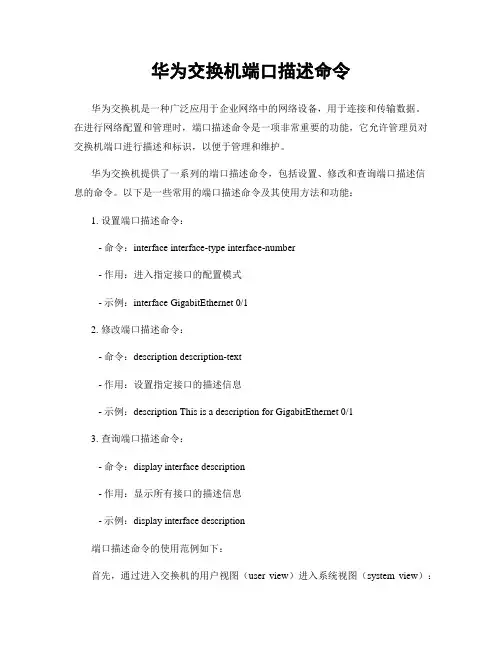
华为交换机端口描述命令华为交换机是一种广泛应用于企业网络中的网络设备,用于连接和传输数据。
在进行网络配置和管理时,端口描述命令是一项非常重要的功能,它允许管理员对交换机端口进行描述和标识,以便于管理和维护。
华为交换机提供了一系列的端口描述命令,包括设置、修改和查询端口描述信息的命令。
以下是一些常用的端口描述命令及其使用方法和功能:1. 设置端口描述命令:- 命令:interface interface-type interface-number- 作用:进入指定接口的配置模式- 示例:interface GigabitEthernet 0/12. 修改端口描述命令:- 命令:description description-text- 作用:设置指定接口的描述信息- 示例:description This is a description for GigabitEthernet 0/13. 查询端口描述命令:- 命令:display interface description- 作用:显示所有接口的描述信息- 示例:display interface description端口描述命令的使用范例如下:首先,通过进入交换机的用户视图(user view)进入系统视图(system view):```<Switch> system-view```然后,进入要设置端口描述的接口的配置模式:```[Switch] interface GigabitEthernet 0/1[Switch-GigabitEthernet0/1]```接下来,设置端口的描述信息:```[Switch-GigabitEthernet0/1] description This is a description for GigabitEthernet 0/1 ```完成后,可以使用查询端口描述命令来验证配置是否成功:```[Switch] display interface description```通过以上步骤,管理员可以方便地对交换机端口进行描述和标识。
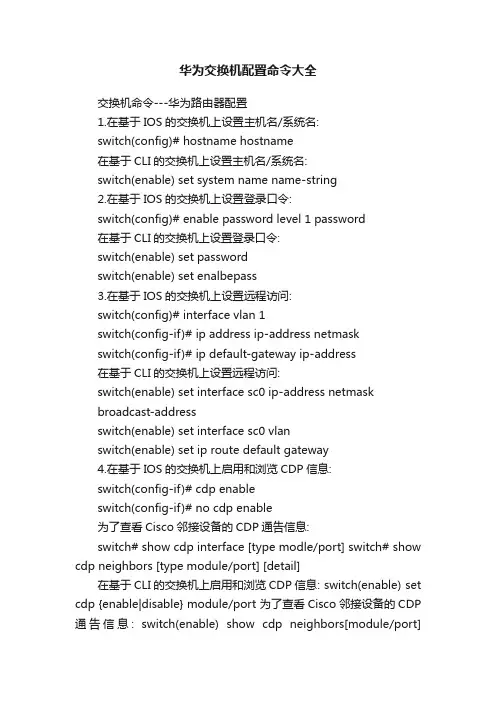
华为交换机配置命令大全交换机命令---华为路由器配置1.在基于IOS的交换机上设置主机名/系统名:switch(config)# hostname hostname在基于CLI的交换机上设置主机名/系统名:switch(enable) set system name name-string2.在基于IOS的交换机上设置登录口令:switch(config)# enable password level 1 password在基于CLI的交换机上设置登录口令:switch(enable) set passwordswitch(enable) set enalbepass3.在基于IOS的交换机上设置远程访问:switch(config)# interface vlan 1switch(config-if)# ip address ip-address netmaskswitch(config-if)# ip default-gateway ip-address在基于CLI的交换机上设置远程访问:switch(enable) set interface sc0 ip-address netmaskbroadcast-addressswitch(enable) set interface sc0 vlanswitch(enable) set ip route default gateway4.在基于IOS的交换机上启用和浏览CDP信息:switch(config-if)# cdp enableswitch(config-if)# no cdp enable为了查看Cisco邻接设备的CDP通告信息:switch# show cdp interface [type modle/port] switch# show cdp neighbors [type module/port] [detail]在基于CLI的交换机上启用和浏览CDP信息: switch(enable) set cdp {enable|disable} module/port 为了查看Cisco邻接设备的CDP 通告信息: switch(enable) show cdp neighbors[module/port][vlan|duplex|capabilities|detail]5.基于IOS的交换机的端口描述:switch(config-if)# description description-string基于CLI的交换机的端口描述:switch(enable)set port name module/number description-string6.在基于IOS的交换机上设置端口速度:switch(config-if)# speed{10|100|auto}在基于CLI的交换机上设置端口速度:switch(enable) set port speed moudle/number{10|100|auto}switch(enable) set port speed moudle/number{4|16|auto}7.在基于IOS的交换机上设置以太网的链路模式: switch(config-if)# duplex {auto|full|half}在基于CLI的交换机上设置以太网的链路模式: switch(enable) set port duplex module/number {full|half}8.在基于IOS的交换机上配置静态VLAN: switch# vlan databaseswitch(vlan)# vlan vlan-num name vlaswitch(vlan)# exitswitch# configure teriminalswitch(config)# interface interface module/number switch(config-if)# switchport mode accessswitch(config-if)# switchport access vlan vlan-num switch(config-if)# end在基于CLI的交换机上配置静态VLAN:switch(enable) set vlan vlan-num [name name] switch(enable) set vlan vlan-num mod-num/port-list9. 在基于IOS的交换机上配置VLAN中继线: switch(config)# interface interface mod/portswitch(config-if)# switchport mode trunkswitch(config-if)# switchport trunk encapsulation {isl|dotlq} switch(config-if)# switchport trunk allowed vlan remove vlan-listswitch(config-if)# switchport trunk allowed vlan add vlan-list 在基于CLI的交换机上配置VLAN中继线: switch(enable) set trunk module/port[on|off|desirable|auto|nonegotiate]Vlan-range [isl|dotlq|dotl0|lane|negotiate] 10.在基于IOS的交换机上配置VTP管理域: switch# vlan databaseswitch(vlan)# vtp domain domain-name在基于CLI的交换机上配置VTP管理域: switch(enable) set vtp [domain domain-name]11.在基于IOS的交换机上配置VTP 模式: switch# vlan databaseswitch(vlan)# vtp domain domain-name switch(vlan)# vtp {sever|cilent|transparent} switch(vlan)# vtp password password 在基于CLI的交换机上配置VTP 模式: switch(enable) set vtp [domain domain-name] [mode{ sever|cilent|transparent }][password password]12. 在基于IOS的交换机上配置VTP版本: switch# vlan databaseswitch(vlan)# vtp v2-mode在基于CLI的交换机上配置VTP版本: switch(enable) set vtp v2 enable13. 在基于IOS的交换机上启动VTP剪裁: switch# vlan databaseswitch(vlan)# vtp pruning在基于CL I 的交换机上启动VTP剪裁: switch(enable) set vtp pruning enable14.在基于IOS的交换机上配置以太信道:switch(config-if)# port group group-number[distribution {source|destination}]在基于CLI的交换机上配置以太信道:switch(enable) set port channel moudle/port-rangemode{on|off|desirable|auto}15.在基于IOS的交换机上调整根路径成本:switch(config-if)# spanning-tree [vlan vlan-list] costcost在基于CLI的交换机上调整根路径成本:switch(enable) set spantree portcost moudle/portcostswitch(enable) set spantree portvlancost moudle/port[cost cost][vlan-list]16.在基于IOS的交换机上调整端口ID:switch(config-if)# spanning-tree[vlan vlan-list]port-priority port-priority在基于CLI的交换机上调整端口ID:switch(enable) set spantree portpri {mldule/port}priority switch(enable) set spantree portvlanpri {module/port}priority [vlans]17. 在基于IOS的交换机上修改STP时钟:switch(config)# spanning-tree [vlan vlan-list] hello-time secondsswitch(config)# spanning-tree [vlan vlan-list] forward-time seconds` switch(config)# spanning-tree [vlan vlan-list] max-age seconds在基于CLI的交换机上修改STP时钟:switch(enable) set spantree hello interval[vlan]switch(enable) set spantree fwddelay delay [vlan]switch(enable) set spantree maxage agingtiame[vlan] 18. 在基于IOS的交换机端口上启用或禁用Port Fast 特征:switch(config-if)#spanning-tree portfast在基于CLI的交换机端口上启用或禁用Port Fast 特征: switch(enable) set spantree portfast {module/port}{enable|disable}19. 在基于IOS的交换机端口上启用或禁用UplinkFast 特征:switch(config)# spanning-tree uplinkfast [max-update-rate pkts-per-second]在基于CLI的交换机端口上启用或禁用UplinkFast 特征: switch(enable) set spantree uplinkfast {enable|disable}[rate update-rate] [all-protocols off|on]20. 为了将交换机配置成一个集群的命令交换机,首先要给管理接口分配一个IP地址,然后使用下列命令: switch(config)# cluster enable cluster-name21. 为了从一条中继链路上删除VLAN,可使用下列命令: switch(enable) clear trunk module/port vlan-range22. 用show vtp domain 显示管理域的VTP参数.23. 用show vtp statistics显示管理域的VTP参数.24. 在Catalyst交换机上定义TrBRF的命令如下:switch(enable) set vlan vlan-name [name name] type trbrf bridge bridge-num[stp {ieee|ibm}]25. 在Catalyst交换机上定义TrCRF的命令如下:switch (enable) set vlan vlan-num [name name] type trcrf {ring hex-ring-num|decring decimal-ring-num} parent vlan-num26. 在创建好TrBRF VLAN之后,就可以给它分配交换机端口.对于以太网交换,可以采用如下命令给VLAN分配端口:switch(enable) set vlan vlan-num mod-num/port-num27. 命令show spantree显示一个交换机端口的STP状态.28. 配置一个ELAN的LES和BUS,可以使用下列命令:ATM (config)# interface atm number.subint multiointATM(config-subif)# lane serber-bus ethernet elan-name 29.配置LECS:ATM(config)# lane database database-nameATM(lane-config-databade)# name elan1-name server-atm-address les1-nsap-addressATM(lane-config-databade)# name elan2-name server-atm-address les2-nsap-addressATM(lane-config-databade)# name …30. 创建完数据库后,必须在主接口上启动LECS.命令如下:ATM(config)# interface atm numberATM(config-if)# lane config database database-nameATM(config-if)# lane config auto-config-atm-address31. 将每个LEC配置到一个不同的ATM子接口上.命令如下:ATM(config)# interface atm number.subint multipointATM(config)# lane client ethernet vlan-num elan-num32. 用show lane server 显示LES的状态.33. 用show lane bus显示bus的状态.34. 用show lane database显示LECS数据库可内容.35. 用show lane client显示LEC的状态.36. 用show module显示已安装的模块列表.37. 用物理接口建立与VLAN的连接:router# configure terminalrouter(config)# interface media module/portrouter(config-if)# description description-stringrouter(config-if)# ip address ip-addr subnet-maskrouter(config-if)# no shutdown38. 用中继链路来建立与VLAN的连接:router(config)# interface module/port.subinterfacerouter(config-ig)# encapsulation[isl|dotlq] vlan-number router(config-if)# ip address ip-address subnet-mask39. 用LANE 来建立与VLAN的连接:router(config)# interface atm module/port router(config-if)# no ip addressrouter(config-if)# atm pvc 1 0 5 qsaalrouter(config-if)# atm pvc 2 0 16 ilnirouter(config-if)# interface atm module/port.subinterface multipointrouter(config-if)# ip address ip-address subnet-maskrouter(config-if)# lane client ethernet elan-numrouter(config-if)# interface atm module/port.subinterface multipointrouter(config-if)# ip address ip-address subnet-namerouter(config-if)# lane client ethernet elan-namerouter(config-if)# …40. 为了在路由处理器上进行动态路由配置,可以用下列IOS命令来进行:router(config)# ip routingrouter(config)# router ip-routing-protocolrouter(config-router)# network ip-network-numberrouter(config-router)# network ip-network-number41. 配置默认路由:switch(enable) set ip route default gateway42. 为一个路由处理器分配VLANID,可在接口模式下使用下列命令:router(config)# interface interface numberrouter(config-if)# mls rp vlan-id vlan-id-num43. 在路由处理器启用MLSP:router(config)# mls rp ip44. 为了把一个外置的路由处理器接口和交换机安置在同一个VTP 域中:router(config)# interface interface numberrouter(config-if)# mls rp vtp-domain domain-name45. 查看指定的VTP域的信息:router# show mls rp vtp-domain vtp domain name46. 要确定RSM或路由器上的管理接口,可以在接口模式下输入下列命令:router(config-if)#mls rp management-interface47. 要检验MLS-RP的配置情况:router# show mls rp48. 检验特定接口上的MLS配置:router# show mls rp interface interface number49. 为了在MLS-SE上设置流掩码而又不想在任一个路由处理器接口上设置访问列表:set mls flow [destination|destination-source|full]50. 为使MLS和输入访问列表可以兼容,可以在全局模式下使用下列命令:router(config)# mls rp ip input-acl51. 当某个交换机的第3层交换失效时,可在交换机的特权模式下输入下列命令:switch(enable) set mls enable52. 若想改变老化时间的值,可在特权模式下输入以下命令:switch(enable) set mls agingtime agingtime53. 设置快速老化:switch(enable) set mls agingtime fast fastagingtime pkt_threshold54. 确定那些MLS-RP和MLS-SE参与了MLS,可先显示交换机引用列表中的内容再确定:switch(enable) show mls include55. 显示MLS高速缓存记录:switch(enable) show mls entry56. 用命令show in arp显示ARP高速缓存区的内容。
华为交换机配置步骤与命令注释1.sys 进入配置模式2.sysname NAME 为交换机配置一个物理场所名字3.Vlan ID 配置一个Vlan4.q 退出当前配置5.【NAME】Interface Ethernet 0/0/1 进入需要配置端口(这条语句是用来为某一个端口绑定ip用的 user-bind static ip-address 10.10.31.1 interface Ethernet0/0/1 )6.【NAME-Ethernet 0/0/1】Port link-type access 设置端口链接类型为access型(还有trunk型)7.【NAME-Ethernet 0/0/1】port default vlan ID 将端口放入所增加的Vlan8.【NAME-Ethernet 0/0/1】q 退出当前配置界面返回前一层9.【NAME】interface vlanif 1 将所配置交换机放入vlanif1 这个是用来进行远程控制的,vlanif1是在核心配置的10.【NAME-vlanif】IP address 10.10.1.34 255.255.255.0 设置一个可以远程登录的IP地址11.【NAME-vlanif】q 退出当前配置界面12.【NAME】IP route-static 0.0.0.0.0.0.0.0 10.10.1.25413.【NAME】aaa14.【NAME】local-user admin service-typ telnet 本地拨号方式15.【NAME-aaa】local-user admin privilege level 15 本地用户分配级别16.【NAME-aaa】q 退出当前状态17.【NAME】user-interface vty 0 418.【NAME-ui-vty0-4】authentication-mode aaa19.【NAME-ui-vty0-4】q 退出当前模式20.【NAME】interface GigabitEthenet 0/0/1 进入G比特网络端口21.【NAME-GigabitEthenet 0/0/1】port link-type trunk22.【NAME-GigabitEthenet 0/0/1】port trunk allow-pass vlan all (或者2to4999)让你想让通过的vlan通过23.<NAME>save 保存所做的设置24.<NAME> q 退出界面欢迎您的下载,资料仅供参考!致力为企业和个人提供合同协议,策划案计划书,学习资料等等打造全网一站式需求。
华为交换机基本配置命令华为交换机基本配置命令大全学习华为认证,一定要先记住华为交换机配置命令,下面yjbys店铺就为大家提供交换机的配置命令,希望对大家有所帮助!一、单交换机VLAN划分命令命令解释system 进入系统视图system-view 进入系统视图quit 退到系统视图undo vlan 20 删除vlan 20sysname 交换机命名disp vlan 显示vlanvlan 20 创建vlan(也可进入vlan 20)port e1/0/1 to e1/0/5 把端口1-5放入VLAN 20 中disp vlan 20 显示vlan里的端口20int e1/0/24 进入端口24port access vlan 20 把当前端口放入vlan 20undo port e1/0/10 表示删除当前VLAN端口10disp curr 显示当前配置二、配置交换机支持TELNETsystem 进入系统视图sysname 交换机命名int vlan 1 进入VLAN 1ip address 192.168.3.100 255.255.255.0 配置IP地址user-int vty 0 4 进入虚拟终端authentication-mode password (aut password) 设置口令模式set authentication password simple 222 (set aut pass sim 222) 设置口令user privilege level 3(use priv lev 3) 配置用户级别disp current-configuration (disp cur) 查看当前配置disp ip int 查看交换机VLAN IP配置删除配置必须退到用户模式reset saved-configuration(reset saved) 删除配置reboot 重启交换机三、跨交换机VLAN的通讯在sw1上:vlan 10 建立VLAN 10int e1/0/5 进入端口5port access vlan 10 把端口5加入vlan 10vlan 20 建立VLAN 20int e1/0/15 进入端口15port access vlan 20 把端口15加入VLAN 20int e1/0/24 进入端口24port link-type trunk 把24端口设为TRUNK端口port trunk permit vlan all 同上在SW2上:vlan 10 建立VLAN 10int e1/0/20 进入端口20port access vlan 10 把端口20放入VLAN 10int e1/0/24 进入端口24port link-type trunk 把24端口设为TRUNK端口port trunk permit vlan all (port trunk permit vlan 10 只能为vlan 10使用)24端口为所有VLAN使用disp int e1/0/24 查看端口24是否为TRUNKundo port trunk permit vlan all 删除该句四、路由的配置命令system 进入系统模式sysname 命名int e1/0 进入端口ip address 192.168.3.100 255.255.255.0 设置IPundo shutdown 打开端口disp ip int e1/0 查看IP接口情况disp ip int brief 查看IP接口情况user-int vty 0 4 进入口令模式authentication-mode password(auth pass) 进入口令模式set authentication password simple 222 37 设置口令user privilege level 3 进入3级特权save 保存配置reset saved-configuration 删除配置(用户模式下运行)undo shutdown 配置远程登陆密码int e1/4ip route 192.168.3.0(目标网段) 255.255.255.0 192.168.12.1(下一跳:下一路由器的接口) 静态路由ip route 0.0.0.0 0.0.0.0 192.168.12.1 默认路由disp ip rout 显示路由列表华3C AR-18E1/0(lan1-lan4)E2/0(wan0)E3/0(WAN1)路由器连接使用直通线。
华为交换机常用命令配置介绍华为交换机是一种常见的网络设备,用于构建大型网络。
配置华为交换机需要使用一些常用的命令,通过这些命令可以设置交换机的各种功能和参数。
本文将介绍一些常用的华为交换机配置命令,包括基本配置、端口配置和VLAN配置等。
一、基本配置命令:1.设置设备主机名:[HUAWEI] sysname Switch //将设备主机名设置为Switch2.配置管理口:[Switch] interface gigabitethernet 0/0/1 //进入GigabitEthernet 0/0/1接口[Switch-GigabitEthernet0/0/1] port link-type access //设置接口类型为access[Switch-GigabitEthernet0/0/1] port default vlan 10 //设置默认VLAN为103.配置IP地址:[Switch-GigabitEthernet0/0/1] ip address 192.168.1.1255.255.255.0 //配置接口IP地址为192.168.1.1,子网掩码为255.255.255.04.设置设备登录认证:[Switch] aaa //进入AAA视图[Switch-aaa] local-user admin //创建本地用户admin[Switch-aaa] password simple admin123 //设置密码为admin1235.开启SSH远程登录:[Switch] ssh server enable //开启SSH服务[Switch] ssh user admin //创建SSH用户admin[Switch-ssh-user-admin] authentication-type password //设置认证方式为密码[Switch-ssh-user-admin] service-type stelnet //设置服务类型为SSH二、端口配置命令:1.查看端口状态:[Switch] display interface gigabitethernet 0/0/1 //查看GigabitEthernet 0/0/1接口的状态信息2.端口速率设置:[Switch] interface gigabitethernet 0/0/1 //进入GigabitEthernet 0/0/1接口[Switch-GigabitEthernet0/0/1] speed 100 //设置速率为100Mbps 3.端口流量控制:[Switch] interface gigabitethernet 0/0/1 //进入GigabitEthernet 0/0/1接口[Switch-GigabitEthernet0/0/1] flow-control //开启流量控制4.端口VLAN成员关系设置:[Switch] interface gigabitethernet 0/0/1 //进入GigabitEthernet 0/0/1接口[Switch-GigabitEthernet0/0/1] port link-type trunk //设置接口类型为trunk[Switch-GigabitEthernet0/0/1] port trunk allow-pass vlan 1020 //设置允许通过的VLAN为10和20三、VLAN配置命令:1.创建VLAN:[Switch] vlan 10 //创建VLAN 10[Switch-vlan10] quit //退出VLAN 10视图2.VLAN接口配置:[Switch] interface vlanif 10 //进入VLAN 10接口[Switch-Vlan-interface10] ip address 192.168.10.1255.255.255.0 //配置接口IP地址为192.168.10.1,子网掩码为255.255.255.03.VLAN端口关联:[Switch] interface gigabitethernet 0/0/1 //进入GigabitEthernet 0/0/1接口[Switch-GigabitEthernet0/0/1] port link-type hybrid //设置接口类型为hybrid(混合)[Switch-GigabitEthernet0/0/1] port hybrid vlan 10 untagged //设置接口为VLAN 10的未标记端口四、其他常用命令:1.查看设备信息:[Switch] display version //查看设备版本信息[Switch] display interface brief //查看所有接口的基本信息2.保存配置:[Switch] save //保存当前配置3.重启设备:[Switch] reboot //重启设备以上是一些常用的华为交换机配置命令。
全面讲解华为交换机配置口令调整端口命令
本文将讲述在基于IOS的华为交换机配置口令上调整端口ID,在基于IOS的华为交换机配置口令端口上启用或禁用Port Fast 特征,命令show spantree显示一个华为交换机配置口令端口的STP状态.
全面讲解华为交换机配置口令调整端口命令,华为交换机配置口令关于调整端口ID、修改STP时钟,顾名思义关于华为交换机配置口令的应用,也会介绍用show vtp statistics 显示管理域的VTP参数。
在基于IOS的华为交换机配置口令上调整端口ID:
switch(config-if)# spanning-tree[vlan vlan-list]port-priority port-priority 在基于CLI的交换机上调整端口ID:
switch(enable) set spantree portpri {mldule/port}priority
switch(enable) set spantree portvlanpri {module/port}priority [vlans] 在基于IOS的华为交换机配置口令上修改STP时钟:
switch(config)# spanning-tree [vlan vlan-list] hello-time seconds
switch(config)# spanning-tree [vlan vlan-list] forward-time seconds
switch(config)# spanning-tree [vlan vlan-list] max-age seconds
在基于CLI的交换机上修改STP时钟:
switch(enable) set spantree hello interval[vlan]
switch(enable) set spantree fwddelay delay [vlan]
switch(enable) set spantree maxage agingtiame[vlan]
在基于IOS的华为交换机配置口令端口上启用或禁用Port Fast 特征:
switch(config-if)#spanning-tree portfast
在基于CLI的交换机端口上启用或禁用Port Fast 特征:
switch(enable) set spantree portfast {module/port}{enable|disable} 在基于IOS的华为交换机配置口令端口上启用或禁用UplinkFast 特征:
switch(config)# spanning-tree uplinkfast [max-update-rate pkts-per-second]
在基于CLI的交换机端口上启用或禁用UplinkFast 特征:
switch(enable) set spantree uplinkfast {enable|disable}[rate update-rate]
[all-protocols off|on]
为了将交换机配置成一个集群的命令交换机,首先要给管理接口分配一个IP地址,然后使用下列命令:
switch(config)# cluster enable cluster-name
为了从一条中继链路上删除VLAN,可使用下列华为交换机配置口令命令:
switch(enable) clear trunk module/port vlan-range
用show vtp domain 显示管理域的VTP参数.
用show vtp statistics显示管理域的VTP参数.
在Catalyst华为交换机配置口令上定义TrBRF的命令如下:
switch(enable) set vlan vlan-name [name name] type trbrf bridge bridge-num[stp {ieee|ibm}]
在Catalyst华为交换机配置口令上定义TrCRF的命令如下:
switch (enable) set vlan vlan-num [name name] type trcrf
{ring hex-ring-num|decring decimal-ring-num} parent vlan-num
在创建好TrBRF VLAN之后,就可以给它分配交换机端口.对于以太网交换,可以采用如下命令给VLAN分配端口:
switch(enable) set vlan vlan-num mod-num/port-num
命令show spantree显示一个华为交换机配置口令端口的STP状态.
配置一个ELAN的LES和BUS,可以使用下列命令:
ATM (config)# interface atm number.subint multioint
ATM(config-subif)# lane serber-bus ethernet elan-name。